Nial Moores, May 13 2014
I visited Baekryeong Island again from April 25th (arriving in the afternoon) to May 9th (departing at 2PM). I was joined on several dates in early May by Prof. Robert Newlin (RN) and on May 5th by Mr. Tim Edelsten (TE).
The main research aims included trying to determine if some species of landbird likely cross Ongjin County on a broad or narrow front (in particular, the three ROK islands of Baekryeong, Daecheong and Socheong; and western Hwanghaenam Province, DPRK); and trying to improve understanding of the effects of weather and source-winds on the numbers of birds that are recorded. Such a baseline understanding is important in interpreting data sets, and in trying to identify population trends in some of these species.
Throughout this survey period, efforts were especially focused on areas of fields and woodland edge in the northeast; and in arable and woodland edge in the far southwest of the island (at Junghwadong). Further observations and counting (of all birds heard and seen, irrespective of distance) were also conducted on three or more dates in the marsh at Hwadong (“Hwadong Wetland”); at Sagot Village in the south; and at Yeonhwa Village in the west. Several visits were also made to an especially large Black-tailed Gull colony kindly introduced to me by one of the islanders.
In total, 195 bird species were recorded, with species of most note including six or seven Black-faced Spoonbill, one (or more probably two) Saker Falcon, Korea’s first Mongolian Lark, one or two Alpine Leaf Warblers, two singing Yellow-streaked Warblers, a singing Sakhalin Leaf Warbler, a Wheatear sp., two Tree Pipit together and presumed national high day-counts of e.g. Yellow-browed Bunting.
Below follows the annotated checklist – the third in a series (with the others covering May 16-31 and November 1-12 2013 (both posted at: http://www.birdskorea.org/Habitats/Other/Baekryeongdo/BK-HA-Baekryeongdo.shmtl), Nomenclature, order and global conservation status follow the 2014 Birds Korea Checklist. For a few species the number of “encounters” is included (the total number of observations on different dates combined, with no allowance for double-counting). All images were taken by NM through a truly superb Swarovski ‘scope and a hand-held Nikon Coolpix. The herculean task of image-editing and layout was most kindly undertaken by Mr. Andreas Kim.
- Greater White-fronted Goose Anser albifrons LC. Six in Hwadong wetland on May 4th was the only record.
- Gadwall Anas strepera LC. Two in Hwadong Wetland on April 26th were last seen on the 30th.
- Eurasian Wigeon Anas penelope LC. Two in Hwadong Wetland were last seen on April 30th.
- Mallard Anas platyrhynchos LC. Ten in Hwadong Wetland on April 25th had decreased to four by April 30th and zero by early May.
- Eastern Spot-billed Duck Anas zonorhyncha LC. The most widespread and numerous duck species, with c. 75 on April 30th the highest day-count.
- Northern Shoveler Anas clypeata LC. Six in Hwadong Wetland on April 25th and one on April 30th.
- Garganey Anas querquedula LC. Between two and three were in Hwadong Wetland on April 25th, with two remaining until the 30th.
- Eurasian Teal Anas crecca LC. Twenty in Hwadong Wetland on April 25th had decreased to six by April 30th.
- Common Pochard Aythya ferina LC. One on Baekryeong Reservoir on April 25th and 30th; and one on Hwadong Wetland on 30th.
- Tufted Duck Aythya fuligula LC. One on Baekryeong Reservoir on April 25th and 30th.
- White-winged Scoter Melanitta deglandi LC. Thirty-three were present off the south of the island on April 25th, with 25 still there on 30th.
- American Scoter Melanitta Americana NT. Twelve were present on the sea on April 25th, with four still present on the 30th.
- Red-breasted Merganser Mergus serrator LC. Two were on the sea to the south of the island on 25th and one was off the east of the island on April 30th.
- Japanese Quail Coturnix japonica NT. Five on April 30th; three on May 1st, two on the 3rd; two suspected on the 5th (TE only); one on the 6th; and one on the 7th.
- Common Pheasant Phasianus colchicus LC. Common and widespread, with 10-25 recorded on most dates.
- Little Grebe Tachybaptus ruficollis LC. Fifteen on April 25th on Baekryeong Reservoir was the highest day-count.
- Great Crested Grebe Podiceps cristatus LC. Five on Baekryeong Reservoir on April 25th was the highest day-count.
- Black-necked Grebe Podiceps nigricollis LC. One in breeding-plumage on Baekryeong Reservoir on April 25th was the only record.
- Black-faced Spoonbill Platalea minor EN. One was in Hwadong Wetland on April 25th. A first-visit to a large Black-tailed Gull colony on April 29th found two adults allopreening quite aggressively (apparently as a prelude to copulation). Repeat visits to the same colony found five there on May 3rd and six on subsequent dates.
- Black-crowned Night Heron Nycticorax nycticorax LC. One on April 25th; three on the 30th; 2+ on May 1st; two on 3rd; and one on 7th.
- Striated Heron Butorides striata LC. Between one and three on most dates.
- Chinese Pond Heron Ardeola bacchus LC. First recorded on May 3rd, and present in small numbers (1-4) on most subsequent dates.
- Eastern Cattle Egret Bubulcus coromandus LC. Between one and five seen on several dates throughout the survey period.
- Grey Heron Ardea cinerea LC. Present in small numbers throughout the survey period with the highest day-count 15 on April 30th.
- Purple Heron Ardea purpurea LC. Two were seen circling Hwadong Wetland on April 30th.
- Great Egret Ardea alba LC. Seen in small numbers (1-4) throughout the survey period.
- Intermediate Egret Egretta intermedia LC. Seen in small numbers (1-3) throughout the survey period.
- Little Egret Egretta garzetta LC. Seen in small numbers (1-3) throughout the survey period.
- Chinese Egret Egretta eulophotes VU. One seen by TE on May 5th and two seen in different parts of the island on May 8th were the only records.
- Pelagic Cormorant Phalacrocorax pelagicus LC. Apparently a breeding species, with small colonies (of < 50 birds) in probably two or three parts of the island.
- Temminck’s Cormorant Phalacrocorax capillatus LC. A breeding species, with small colonies (of <100 birds) in probably two or three parts of the island.
- Western Osprey Pandion haliaetus LC. One on April 29th was the only record.
- Crested Honey Buzzard Pernis ptilorhynchus LC. Surprisingly scarce (as in 2013), with two on May 3rd and one on the 9th the only records. From the return ferry to Incheon on the 9th, at least 14 were moving east down Socheong Island, with one also seen over the sea about 8km south of the island. It seems likely that many of the Crested Honey Buzzard recorded on Socheong arrive from the southwest (or south?), rather than after undertaking a west-east flight from the Shandong Peninsula.
- Chinese Sparrowhawk Accipiter soloensis LC. An adult male was seen on the rather early date of May 2nd. The only other record was of one on May 7th.
- Japanese Sparrowhawk Accipiter gularis LC. Singles were seen almost daily. One was heard giving mewing calls in woodland in the northeast of the island on May 3rd and appeared thereafter to be paired-up and in territory.
- Eurasian Sparrowhawk Accipiter nisus LC. One on April 30th and one in May 2nd were apparently the only records.
- Eastern Marsh Harrier Circus spilonotus LC. One over Hwadong Wetland on April 30th was the only record.
- Pied Harrier Circus melanoleucos LC. A female in fields at Jincheon on May 1st and a (presumed) Second calendar-year male on May 8th.
- Black Kite Milvus migrans LC. One heard winnowing on April 25th was the only record.
- Grey-faced Buzzard Butastur indicus LC. Three on April 25th; 5+ on April 30th; three on May 2nd; two on May 8th; and four on May 9th.
- Common Moorhen Gallinula chloropus LC. Present in small numbers (1-5) throughout the survey period in the Hwadong Wetland and at Yeonhwa.
- Eurasian Coot Fulica atra LC. Present throughout the survey period in small numbers (5-10) on the Baekryeong Reservoir and in the Hwadong Wetland, with a high count of 15+ on April 25th.
- Far Eastern Oystercatcher Haematopus (ostralegus) osculans LC. Present throughout the period in small numbers. Probably 15-20 were present on the island, with the first bird apparently sitting on the nest seen on May 3rd.
- Black-winged Stilt Himantopus himantopus LC. Seven were in Hwadong Wetland on April 30th; and one or more were heard there again on May 1st.
- Pacific Golden Plover Pluvialis fulva LC. One on April 26th, and one on 28th
- Little Ringed Plover Charadrius dubius LC. Apparently in territory in three or four sites on the island, with the high-count a modest 11+ on April 25th.
- Kentish Plover Charadrius alexandrinus LC. Two on 25th and three on the 30th, including one larger bird showing some (but not all!) features suggesting “White-faced Plover”. One pair appeared to be in territory in the Hwadong Wetland.
- Mongolian Plover Charadrius mongolus LC. One was in salt-pans in Hwadong Wetland on April 30th.
- Latham’s Snipe Gallinago hardwickii LC. One on April 30th, two on May 1st, one on 2nd and one on May 8th.
- Pin-tailed Snipe Gallinago stenura LC. Based on calls, considered to be the second most numerous shorebird on the island during the survey period. At least six were heard in the late evening of April 25th; six were heard on the 30th; approximately 40 were seen and heard on May 1st (including a single flock of 27 watched coming in off the sea and moving east across the island); ten on the 3rd; two on the 6th; and 30 on the 8th.
- Swinhoe’s Snipe Gallinago megala LC. Based on calls, and on flight views of bulky, dark-looking “swintail snipes” at least one probable on April 30th and one definite on May 8th.
- Common Snipe Gallinago gallinago LC Recorded on only four dates, with the highest count three on April 26th and again on May 8th.
- Little Whimbrel Numenius minutus LC. One was heard in rice-fields east of Baekryeong Reservoir at 0430 on May 1st.
- Whimbrel Numenius phaeopus LC. On April 25th, six were on the main beach in the south and three departed the island from the northeast in the evening. Subsequently, ones and twos were seen or heard on several dates until at last May 4th.
- Far Eastern Curlew Numenius madagascariensis VU. A total of three: two were on the main southern beach from April 25th to 27th and one was in the main harbor on April 26th.
- Common Redshank Tringa totanus LC. One was in Hwadong Wetland on April 30th and May 1st.
- Marsh Sandpiper Tringa stagnatilis LC. Three were in the Hwadong Wetland on April 25th and four were there on the 30th.
- Common Greenshank Tringa nebularia LC. Recorded more or less every day in small numbers (1-5) throughout the survey period, with 11 seen overflying the island on May 9th the highest day-count.
- Green Sandpiper Tringa ochropus LC. Recorded more or less daily throughout the survey period in small numbers (2-5) with the highest count 10+ on April 30th.
- Wood Sandpiper Tringa glareola LC. First noted on April 28th (two), with the highest counts involving flocks in active across-island flight, including c. 75 on May 1st; and 43 departing the island in the evening of May 8th.
- Grey-tailed Tattler Tringa brevipes LC. Recorded on only three dates, with the highest day-count five on April 27th and the last one heard in the early hours of May 1st.
- Terek Sandpiper Xenus cinereus LC. Recorded on only four dates, with four on April 25th, two on April 27th; eight on 30th; and one on May 1st.
- Common Sandpiper Actitis hypoleucos LC. First recorded on April 28th (when three), with the highest day count 6+ on 30th
- Great Knot Calidris tenuirostris VU. One overflew the island in rain at moderate height at 17:45, heading northeast.
- Red-necked Stint Calidris ruficollis LC. One on April 27th’ and 3+ on 30th
- Temminck’s Stint Calidris temminckii LC. One was in Hwadong Wetland on April 30th.
- Long-toed Stint Calidris subminuta LC. There were 6+ on April 30th in Hwadong Wetland; and one in Jincheon on May 1st and 2nd.
- Sharp-tailed Sandpiper Calidris acuminata LC. One (or two) was in rice-fields and in Hwadong wetland on April 30th.
- Black-headed Gull Chroicocephalus ridibundus LC. Five on April 25th and one on April 30th.
- Black-tailed Gull Larus crassirostris LC. The most numerous species recorded on the island, with several breeding colonies. The largest colony held a minimum 12,000 to 13,000 individuals (counted on two different dates, first in 100s and then in 10s and 100s), with other colonies also holding several hundred pairs. All sitting and the vast majority of attending birds were fully adult, though a few hundred non-breeders (several of which apparently retained a fair amount of juvenile plumage from last year) were also in attendance.
- Common Gull Larus canus LC. One on April 25th was the only record.
- Mongolian Gull Larus mongolicus LC. Small numbers were present throughout the survey period, and the species is likely breeding at one site on the island.
- Slaty-backed Gull Larus schistisagus LC. One was on the main south beach on April 30th; and an immature was in Junghwadong harbor on May 1st.
- Taimyr Gull Larus heuglini taimyrensis LC. Two were on the main southern beach on April 30th.
- Oriental Turtle Dove Streptopelia orientalis LC. Present and widespread throughout the island during the survey period, with 40+ on May 1st the highest day-count.
- Indian Cuckoo Cuculus micropterus LC. One on May 4th was the only record.
- Oriental Cuckoo Cuculus optatus LC. One or two were heard on several dates, first on April 25th and last on May 8th.
- Common Cuckoo Cuculus canorus LC. One heard on May 7th was the only record.
- Oriental Scops Owl Otus sunia LC. One or two were heard most evenings / early mornings throughout the survey period (first on April 25th, last on May 9th). Only one (a rufous morph) was seen (in Jincheon on May 9th)
- Northern Boobook Ninox japonica LC. One or two were apparently in territory in Jincheon throughout the survey period, with one seen in high flight twice over the suspected breeding site during the day; and one other heard near Hwadong Wetland on May 1st.
- Grey Nightjar Caprimulgus jotaka LC. One heard pre-dawn in woodland near Hwadong on May 1st and one heard in Jincheon the same evening were the only records.
- White-throated Needletail Hirundapus caudacutus LC. Seen only twice: two on April 29th and 5+ on 30th
- Pacific Swift Apus pacificus LC. Seen most days in small numbers (2-5) with the highest counts 20 on April 30th and 10+ on May 1st, 6th and 8th.
- Oriental Dollarbird Eurystomus orientalis LC. One seen by RN on May 6th was the only record.
- Common Kingfisher Alcedo atthis LC. Present in small numbers (2-5) throughout the survey period, with a high count of 10+ on May 1st.
- Eurasian Hoopoe Upupa epops LC. One, of a pair, singing in Jincheon on April 26th was seen carrying food in the same area on May 8th.
- Eurasian Wryneck Jynx torquilla LC. Recorded on six dates, with the first one on April 30th and the last on May 8th and the highest day-count four (on May 1st, in the southwest).
- Great Spotted Woodpecker Dendrocopos major LC. One or two were in Yeonhwa Village during the survey period.
- Common Kestrel Falco tinnunculus LC. One on April 25th was the only record.
- Amur Falcon Falco amurensis LC. One male and one female were seen over Jincheon during an arrival on May 6th; and two males were seen on May 8th.
- Eurasian Hobby Falco subbuteo LC. First seen on April 30th (when two) and thereafter seen each day, with a high count of five on May 9th.
- Saker Falcon Falco cherrug EN. A large brown-backed falcon with a mainly white head seen distantly in the west of the island on May 3rd was presumably this species. A different brown-above individual (with a more strongly marked head pattern and a warmer-toned tail) seen during the arrival of the 6th was more confidently identified as a Saker based on the contrast on the upperwing and especially because it showed a dark line across the underwing coverts that was clearly visible in ‘scope views. Surprisingly, May seems to be a good month for finding this species along the west coast and on offshore islands.
- Peregrine Falcon Falco peregrinus LC. Present throughout the survey period, with one pair apparently nesting on cliffs towards the southwest and an additional three or more individuals seen in other parts of the island.
- Ashy Minivet Pericrocotus divaricatus LC. Recorded more or less every day, with the highest day-counts 60 on April 30th and 80-90 on May 1st.
- Bull-headed Shrike Lanius bucephalus LC. Small numbers (perhaps 2-3 pairs) were present throughout the survey period, with one pair attending two recently-fledged juveniles in Junghwadong on May 5th.
- Brown Shrike Lanius cristatus LC. First recorded on May 1st (when two in the far southwest) and thereafter recorded daily in small numbers, with the highest day-counts 10 on May 4th and 12 on May 8th.
- Black-naped Oriole Oriolus chinensis LC. First-recorded on May 1st and subsequently recorded daily with the highest day count 89 (all in active flight) on May 7th.
- Black Drongo Dicrurus macrocercus LC. One was in the north of the island on May 7th.
- Eurasian Jay Garrulus glandarius LC. Present throughout the survey period, with the highest day-count 74 on April 30th, including a flock of 64 attempting to depart the island towards the east (many apparently succeeded, as they were seen to tower and not to return). A restless flock of 51 was also present in the far east of the island on May 9th
- Azure-winged Magpie Cyanopica cyanus LC. Present in the south and west of the island with the highest day-count 25 and a total of c. 50 on the island as a whole (as in late May 2013).
- Eurasian Magpie Pica pica LC. At least four birds were present in the east of the island (n Jincheon and in Sagot Village).
- Large-billed Crow Corvus macrorhynchos LC. Present throughout the survey period with 2-10 seen most dates.
- Japanese Waxwing Bombycilla japonica NT. One on April 26th, 28th and 30th; three on May 6th; and six on May 8th.
- Coal Tit Periparus ater LC. Only one record during the present survey: one singing in Jincheon on May 9th.
- Yellow-bellied Tit Pardaliparus venustulus LC. Two records, both in the southwest, with one heard on the 28th and a Second Calendar-year male seen on May 1st.
- Eastern Great Tit Parus minor LC. Present throughout the survey period in small numbers in all areas of the island. Probably 25-40 pairs present in total in areas that were surveyed.
- Chinese Penduline Tit Remiz consobrinus LC. Small numbers (1-3) recorded on several dates, with birds singing in two locations.
- Mongolian Lark Melanocorypha mongolica LC. One was found and digiscoped by NM in fields in Jincheon at 18:25 on May 6th (a day with a fair weather arrival of birds), and was also seen and photographed in the same field by RN together with NM from about 18:45. It was not found on 7th or 8th, despite a fairly extensive search. Although this species has reached Japan (once, in spring) and has also been recorded once on the Liaoning Peninsula (on November 9th 2013: Tom Beeke via Bird Forum), this is the first record of the species in Korea. Mongolian Lark will therefore be added to Category One of the Birds Korea Checklist in the next update.
- Light-vented Bulbul Pycnonotus sinensis LC. Common (and vocal) throughout the survey period in all areas that were surveyed, with 20-30 counted on several days, 50 logged on May 1st, and multiple pairs seen nest-building. There was also some suggestion of additional birds arriving during May. In the second half of May 2013, 25-50 pairs were estimated to be present on the island.
- Brown-eared Bulbul Hypsipetes amaurotis LC. Between five and twenty recorded most dates: notably less numerous than Light-vented Bulbul.
- Sand / Pale Martin Riparia riparia / Riparia diluta LC. First recorded on May 2nd, when eight were seen over Jincheon; 5+ were then on the 6th; two on the 7th and 10+ on the 8th. All that were seen well showed a decent tail fork; strong breast bands and darkish brown tones on the head and upperparts and thus seem most likely to be Sand Martin.
- Barn Swallow Hirundo rustica LC. Recorded more or less daily throughout the survey period, with highest day-counts 250 on April 30th, 150 on May 6th and 200 on May 8th.
- Common House Martin Delichon urbicum LC. One on April 30th was the only record.
- Asian House Martin Delichon dasypus LC. Recorded only once: one on May 8th.
- Red-rumped Swallow Cecropis daurica LC. Recorded near-daily throughout the survey period, with highest day-counts 250 on May 2nd and 150 on May 8th.
- Korean Bush Warbler Horornis borealis LC. Present throughout the survey period, with the highest day-count 15+ on May 1st.
- Asian Stubtail Urosphena squameiceps LC. Remarkably scarce when considering numbers recorded on Socheong Island in previous years. One or two were recorded on five or so dates and the highest day-count was a modest 30 on May 1st.
- Long-tailed Tit Aegithalos caudatus LC. Small groups were recorded on several dates in at least five parts of the island, suggesting a total island population of perhaps 30-40 birds. As in 2013, all individuals that were seen well were white-headed.
- Dusky Warbler Phylloscopus fuscatus LC. Recorded daily during the survey, mostly in small numbers (1-5), with highest day-counts 13 on May 1st; 35 on the 4th; 20+ on the 5th and 15+ on the 8th.
- Alpine Leaf Warbler Phylloscopus occisinensis LC. One highly confiding individual was found in Junghwadong on May 4th. It was present in the same group of bushes on the 5th. The same, or another, was also seen 850m to the east on May 7th. There are only eleven or so previous records of the species in the ROK, including the one on Baekryeong on May 19th 2013. However, the species appears to be a regular May overshoot migrant to West Sea islands, as in the past ten years there have also been records from Gageo (one on May 3rd 2009 by NM); Eocheong (one on May 11th 2010 seen by two visiting birders and one photographed poorly on May 13th 2011 by NM); Weiyeon (one in May 2013 seen by RN); and Socheong (three, two of which were photographed, in May 2005; one on May 12th and 13th 2009 photographed and sound-recorded by NM; one on May 24th 2011 seen by Jens Thalund; and one in May 2013 photographed by Kim Sung-Hyun and Choi Soon-Kyoo).
- Yellow-streaked Warbler Phylloscopus armandii LC. One was heard and seen calling and was then digiscoped extremely poorly in song in Junghwadong just before the start of a heavy rain storm in the late afternoon of May 7th. A return to the same area in the morning of the 8th found two birds singing from adjacent patches of bushes – with one of these birds remaining vocal, but largely hidden, for several hours in the same bushes as on the 7th, eventually allowing two-seconds of digiscoped video and several recordings of vocalisations through the camera. This rather poorly-known species (at least to ornithologists and birders here) has been recorded fewer than five times in the ROK but is undoubtedly overlooked as it apparently occurs regularly as close as the Shandong Peninsula. It is generally rather skulking (preferring dense bushes); its call and song are distinctive but not striking; and plumage-wise it appears initially rather unremarkable, though is subtly beautiful and rather more distinctive-looking than most field-guides suggest.To assist observers with finding this species here, a fuller ID description (based on several encounters with the species, first in China and more recently in the ROK, follows):The call is best described as being rather locustella–like (rather than bunting-like), a short “ttuk” or “ttik”. This note is sometimes given singly but is also often run together – or at least given in a rapid series. It is obviously much less stone-clicking or disapprovingly tutting than Dusky Warbler and quieter and less anxious-sounding and multi-syllabic than Radde’s. The song is fairly short and simple, with a swinging rhythm and length recalling Styann’s Grasshopper Warbler though with a bunting-like flourish. The song lacks the rich Nightingale-like quality of the trilled phrases given by Radde’s or the complexity of some Dusky Warbler songs.Structurally Yellow-streaked is more or less intermediate between Radde’s and Dusky. The individual that was seen reasonably well on 7th and 8th appeared long-tailed, and a little big-headed (suggesting a Radde’s head on a Dusky’s body), with pinkish legs lacking the yellower toes or strength and thickness of Radde’s. Its plumage was fairly pale brown above (paler above than Radde’s or most worn Dusky and lacking the obvious greenish remiges’ blaze of the former species). Below, it was strikingly pale-throated and breasted; had brownish breast sides and unique to this species in spring at least was washed weakly yellow across much of the remainder of the underparts, with a rust- or orangey-washed vent and clearer yellow on the chin. Its supercilium, set off by subtly darker lateral crown stripes, was long and pale, also faintly yellow-tinged to the rear and browner to the fore, showing more contrast than Dusky and a better definition to the fore than Radde’s.
- Radde’s Warbler Phylloscopus schwarzi LC. First recorded on May 1st (when three were found) and found near-daily subsequently, with highest day-counts 10 on the 5th and 20+ on the 8th, with many in full song.
- Pallas’s Leaf Warbler Phylloscopus proregulus LC. This typically early migrant was recorded in small numbers on only five dates, with the highest day-count 12 on May 1st and the last record on May 5th.
- Yellow-browed Warbler Phylloscopus inornatus LC. The most numerous warbler during the survey period, with several peaks and troughs in number. The highest day-counts were 150 on April 30th; 750+ on May 1st (when probably several thousand were on the island); 100 on the 3rd and 120 on the 4th.
- Hume’s Leaf Warbler Phylloscopus humei LC. Taking a necessarily very conservative ID approach, this species was recorded on only three dates, with one on May 1st; two on the 2nd and one on the 8th.
- Arctic Warbler Phylloscopus borealis LC. Only one record of this late migrant: one was heard calling on May 8th.
- Pale-legged Leaf Warbler Phylloscopus tenellipes LC. Recorded on most days of the survey (though singing was heard on only three dates) but only in small numbers (1-5), with the highest count a mere six (on May 7th).
- Sakhalin Leaf Warbler Phylloscopus borealoides LC. One was heard (and poorly sound-recorded) in Jincheon on April 28th. Presumably the same individual was still present and in song in the same area on the 30th. This is presumed to be the second record for Baekryeong (with one heard in song on May 19th 2013).
- Eastern Crowned Warbler Phylloscopus coronatus LC. Recorded on most dates of the survey in small numbers (1-5), with the highest day-counts 20+ on May 1st and 20 on the 2nd.
- Oriental Reed Warbler Acrocephalus orientalis LC. First recorded on April 30th (in Hwadong Wetland) and subsequently recorded on most dates in very small numbers (1-2).
- Black-browed Reed Warbler Acrocephalus bistrigiceps LC. One was in Jincheon on May 8th.
- Far Eastern Cisticola Cisticola juncidis brunniceps LC. Two were singing in Hwadong Wetland on April 25th with one still present there on May 1st.
- Chestnut-flanked White-eye Zosterops erythropleurus LC. First recorded on May 1st (when 20 seen), increasing thereafter. The highest day-count was on the 9th, when 330 passed east / northeast in only 70 minutes of visible migration counts, most in groups of between 30 and 50. As birds were heard and seen throughout the morning (with a flock of 50+ also in trees by the ferry terminal) it is likely that many hundreds (or even low thousands) passed through Baekryeong Island on this day.
- Japanese White-eye Zosterops japonicus LC. All individuals seen well were simplex. First found on April 27th, when 10-12 were in Jincheon, with a highest day-count of 25 on May 2nd (when flocks were found in three areas of the island). The species was more difficult to identify with confidence on call once Chestnut-flanked White-eyes became more numerous. The last Japanese White-eye identified on plumage was on May 3rd.
- Red-billed Starling Spodiopsar sericeus LC. Between one and three were recorded on five dates between April 26th and May 8th.
- White-cheeked Starling Spodiopsar cineraceus LC. Recorded in small numbers on most dates, with 12+ on April 28th the highest day-count.
- Daurian Starling Agropsar sturninus LC. Between one and three were recorded on five dates between April 30th and May 7th, probably involving 7-8 different individuals.
- Chestnut-cheeked Starling Agropsar philippensis LC. A female was seen near Baekryeong Reservoir on May 4th and 5th.
- Siberian Thrush Geokichla sibirica LC. Two on May 8th was the only record.
- White’s Thrush Zoothera aurea LC. Recorded more or less daily in small numbers (1-5) after the first on April 30th, with 15+ on May 1st the highest day-count.
- Grey-backed Thrush Turdus hortulorum LC. From April 28th, recorded daily in small numbers (3-10), with 30+ on May 1st the highest day-count.
- Chinese Blackbird Turdus merula mandarinus LC. One was in Sagot Village on April 25th and one or two were near Kaul Village on May 7th.
- Eyebrowed Thrush Turdus obscurus LC. First recorded on May 1st (when three were found), and subsequently recorded daily in mostly small numbers with 75 on the 4th the highest day-count.
- Pale Thrush Turdus pallidus LC. Ones or twos were recorded daily until April 30th.
- Dusky Thrush Turdus eunomus LC. Recorded in small numbers (1-5) most days, with 30 counted on April 30th and two still present on the 9th.
- Grey-streaked Flycatcher Muscicapa griseisticta LC. Recorded daily from May 1st, with the highest day-counts four on the 4th and the 7th.
- Asian Brown Flycatcher Muscicapa latirostris LC. Recorded daily from April 28th (when four), with the highest day-count 12 on May 4th.
- Blue-and-white Flycatcher Cyanoptila cyanomelana LC. The most frequently-encountered flycatcher during the present survey, recorded on all dates (apart from May 7th) from April 27th (when three were found). In total there were 72 “encounters” with the species, with the highest day-count 26 on the 28th (when all males were of the nominate subspecies). The first male intermedia was found on May 3rd.
- Siberian Blue Robin Larvivora cyane LC. Rather scarce, with singles recorded on only four dates (first on May 1st).
- Rufous-tailed Robin Larvivora sibilans LC. Recorded almost daily after the first two were heard singing on May 1st. The peak count of this mid-May migrant was 6+ on the 8th.
- Bluethroat Luscinia svecica LC. A total of three males were seen (and photographed), all in May: one in Junghwadong on 1st; one in Yeonhwa Village on May on 3rd and 5th; and one in Jincheon on 6th.
- Siberian Rubythroat Calliope calliope LC. Rather scarce, being recorded on only four dates. The first were noted on May 1st (when three were in the southwest) and the peak count was only 10+ (on the 5th).
- Red-flanked Bluetail Tarsiger cyanurus LC. Presumably this survey missed the peak migration period of this early-migrating species. Recorded on only five dates, there were only 12 “encounters” with this species, with the highest day-count four on April 26th and the last observation on May 3rd.
- Yellow-rumped Flycatcher Ficedula zanthopygia LC. Recorded daily after the first two were found on April 30th. In total there were 49 “encounters” with this species and a highest day-count of 23 (on May 1st).
- Narcissus Flycatcher Ficedula narcissina LC. Three records during the survey period, all in Jincheon: a Second Calendar-year male on April 30th; a less well-marked male on May 1st; and 1-2 females on May 8th.
- Mugimaki Flycatcher Ficedula mugimaki LC. First found on May 4th, with 2-6 found on subsequent dates.
- Taiga Flycatcher Ficedula albicilla LC. Recorded on nine dates, first on April 28th, with a total of 64 “encounters” and the highest day-count 18 on May 4th. At least two otherwise standard-looking and –sounding males showed orange-blotches on the underparts.
- Daurian Redstart Phoenicurus auroreus LC. Small numbers (<3) were seen on several dates, with one pair suspected of nesting in the far southwest. A male seen in the far southwest of the island on May 4th and 5th was strikingly-plumaged when compared with typical males in Korea at the same time of year, with a near-white crown and black mantle lacking obvious browner edges: plumage wear or from a different source area than most Korean breeding birds?
- Blue Rock Thrush Monticola solitarius LC. Present in small numbers within 250m of and along the coast, with probably 5-10 territories in areas visited during the present survey.
- Stejneger’s Stonechat Saxicola stejnegeri LC. Recorded more or less daily during the survey, mostly in small numbers (1-5), with a total of 120 “encounters”, and highest day-counts of 30+ on May 4th and 25 on the 6th.
- Wheatear sp. One, probably a Northern Wheatear, was seen in sustained flight over Jincheon from the motel at the start of a fair-weather arrival of birds on May 6th. Few plumage details were seen, although in bright conditions the bird appeared brownish above, with weak contrast on the head, and also showed a striking white rump and a clear black and white T-tail pattern (presumably ruling out both Desert and Isabelline?). It also had clearly pale underwings (lacking the blackish underwing coverts and contrast of Pied).
- Russet Sparrow Passer rutilans LC. A male was in the west on May 5th and a pair was in the same area on May 7th.
- Eurasian Tree Sparrow Passer montanus LC. Common and widespread around habitation throughout the island, with probably>100 pairs present in total.
- Forest Wagtail Dendronanthus indicus LC. Noted on only three dates, with two on May 3rd, one on 5th and one on the 9th.
- Eastern Yellow Wagtail Motacilla tschutschensis LC. The most numerous wagtail during the survey period, noted daily from the first on April 30th (when 150+ were counted), with 3-50 on subsequent dates. The first taivana were noted on May 5th.
- Grey Wagtail Motacilla cinerea LC. Recorded more or less daily in small numbers of 1-15.
- White Wagtail Motacilla alba LC. Recorded more or less daily in small numbers of 2-25, with the highest day-count only 60 (on May 3rd). The vast majority were ocularis.
- Richard’s Pipit Anthus richardi LC. Recorded daily from April 30th (when five) to the end of the survey period, with the highest day-count 20+ on May 7th.
- Blyth’s Pipit Anthus godlewskii LC. Only two were found during the survey period with singles on May 4th and 5th.
- Tree Pipit Anthus trivialis LC. Two together were found and photographed in the southwest of the island on May 5th. This is believed to be the first record of more than one together in the ROK.
- Olive-backed Pipit Anthus hodgsoni LC. The most numerous pipit, noted daily though not recorded in numbers comparable with high-counts recorded at the same time of year on Gageo and Eocheong Islands a decade or so ago. Highest day-counts were only 200 on April 30th and 350 on May 1st.
- Pechora Pipit Anthus gustavi LC. Recorded on six dates, with a maximum of 13 birds noted. First recorded on April 26th when four were seen and heard; and last on May 7th. Based on flight views, calls and dates, it seems likely that earlier individuals (total of seven) were more likely menzbieri, with the first nominate seen on May 3rd.
- Red-throated Pipit Anthus cervinus LC. The second most numerous pipit during the survey period, with 60 on April 25th and 50 on April 30th the highest day-counts and small numbers still present at the end of the survey period.
- Buff-bellied Pipit Anthus rubescens LC. Present in very small numbers throughout the survey period, with the highest day count only three (on April 25th) and a single bird remaining in the west until at least May 5th.
- Brambling Coelebs montifringilla LC. Present throughout, mostly in small numbers, with highest day-counts of 200 on May 2nd and 180 on May 8th.
- Hawfinch Coccothraustes coccothraustes LC. One or two were recorded on five or so dates.
- Chinese Grosbeak Eophona migratoria LC. Present throughout the survey period in small numbers (10-30) in the northeast, west and southwest. On May 7th, larger numbers of this species were on the move across the island, and a total of 245 (perhaps a recent national high-count?) were counted in the west and northeast.
- Japanese Grosbeak Eophona personata LC. Two apparently arrived in the fair weather arrival in the afternoon of May 6th
- Common Rosefinch Carpodacus erythrinus LC. Surprisingly scarce, with one heard on May 9th the only record.
- Grey-capped Greenfinch Chloris sinica LC. Present throughout in small numbers (with a highest day-count of 30), with several full-grown juveniles first noted on April 28th.
- Red Crossbill Loxia curvirostra LC. Present throughout the survey period, with 1-4 in the northeast; up to eight in the west; and a peak count of 35 in the southwest (on May 1st). At least some of the males had paler vents with darker markings. However, based on a very wide difference in calls between birds and groups of birds, it is unclear whether one or more types or if one or two subspecies were involved. The best views were of the birds in the west (including the male in the image), which when in pairs gave rapidly-repeated “Duweet” calls suggestive of e.g. Chinese Nuthatch.
- Eurasian Siskin Spinus spinus LC. Present throughout the survey period in small numbers, with the highest day-counts 75 on April 30th and 200 on May 2nd.
- Meadow Bunting Emberiza cioides LC. Present in small numbers throughout the island, with probably only 5-10 territories present in those areas that were surveyed.
- Tristram’s Bunting Emberiza tristrami LC. Recorded more or less daily, with a high count of only 10 (on April 30th). This species was no doubt overlooked as it generally favours wooded areas (poorly covered by the present survey).
- Chestnut-eared Bunting Emberiza fucata LC. Recorded almost daily, with highest day-counts 20+ on April 30th; and 20 (only in the northeast) on May 6th.
- Little Bunting Emberiza pusilla LC. Recorded daily, with highest counts (all in the northeast) of 75 on April 26th (including a single flock of 60, all in song); 75 on May 4th; and 220 on May 6th (including one flock of 180).
- Yellow-browed Bunting Emberiza chrysophrys LC. One of the commonest grounded migrants during the survey period, with 450 counted on May 1st presumably representing a new national high day-count. Between two and seven were in Jincheon between April 25th and 27th with an additional ten in the southwest on the 28th. Numbers increased rapidly after the rain at month’s end, with 100+ in the east of the island on the 30th; and 100 in the southwest and c. 350 in the northeast on May 1st. Numbers fell subsequently, with 200 still present in a small area in the northeast of the island on May 2nd; 250 counted on the 3rd in Jincheon and Yeonhwa; and 100 present in the northeast and southwest on the 4th. A maximum of 20-30 were counted on subsequent dates.
- Rustic Bunting Emberiza rustica LC. The last record was one on April 26th.
- Yellow-throated Bunting Emberiza elegans LC. Small numbers (5-10) were recorded most dates, with several birds apparently in territory.
- Yellow-breasted Bunting Emberiza aureola EN. All males seen well enough to identify to subspecies were ornata. First recorded on April 30th, when three were in Hwadong Wetland. One male was in Jincheon on May 2nd; four were counted on May 3rd; three on May 5th (in the west); and at least 100 (mostly males) were present in fields in Jincheon on the 6th (with most of these seen to arrive during the day). This peak count (perhaps the highest day-count in the ROK for several years?) fell to 30 on the 7th with only two seen on the 8th.
- Chestnut Bunting Emberiza rutila LC. First noted on May 1st (when two or three were heard singing), with five on the 4th and a high count of c. 100 on the 6th (most of which were involved in a fair-weather arrival).
- Yellow Bunting Emberiza sulphurata VU. An adult male was in Junghwadong on May 1st. This species is very scarce on the northwestern islands.
- Black-faced Bunting Emberiza spodocephala LC. Recorded daily in small numbers (2-30) until April 30th when at least 500 were recorded in the east of the island. The highest day count was 550 on May 1st with numbers falling steadily again, until they increased again from 35 on the 5th to at least 150 on the 6th. The majority of individuals showed some yellow tones on the underparts (and could therefore be ascribed to extremiorientis), though c. 50 on May 6th were much greyer and more likely of the nominate subspecies. No personata were found.
- Pallas’s Reed Bunting Emberiza pallasi LC. Recorded in very small numbers throughout the survey period, with the highest day count only three (on April 30th) and the final observation on May 7th.
- Ochre-rumped Bunting Emberiza yessoensis NT. One male in partial breeding plumage in Hwadong Wetland was the only record.
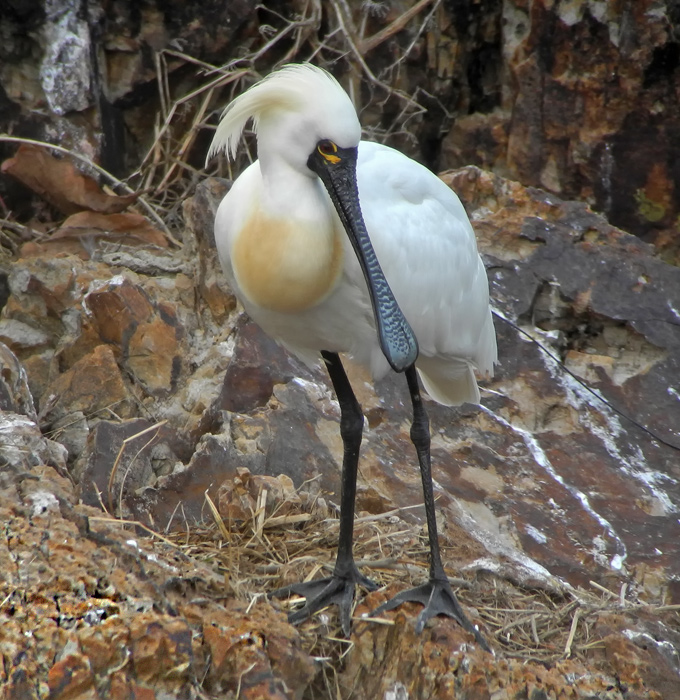
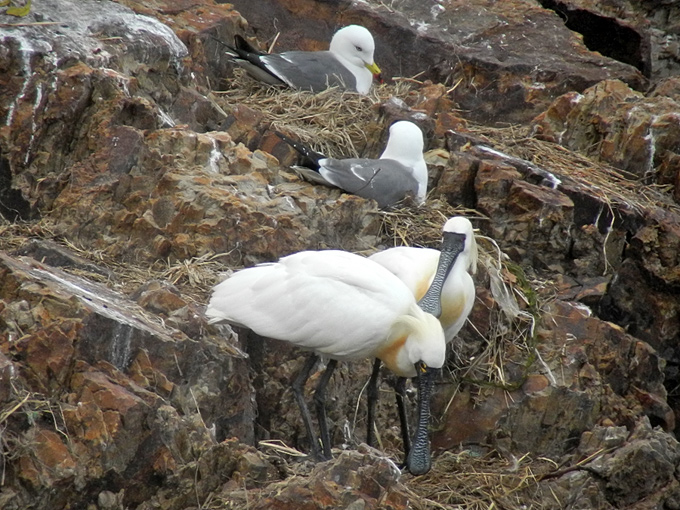

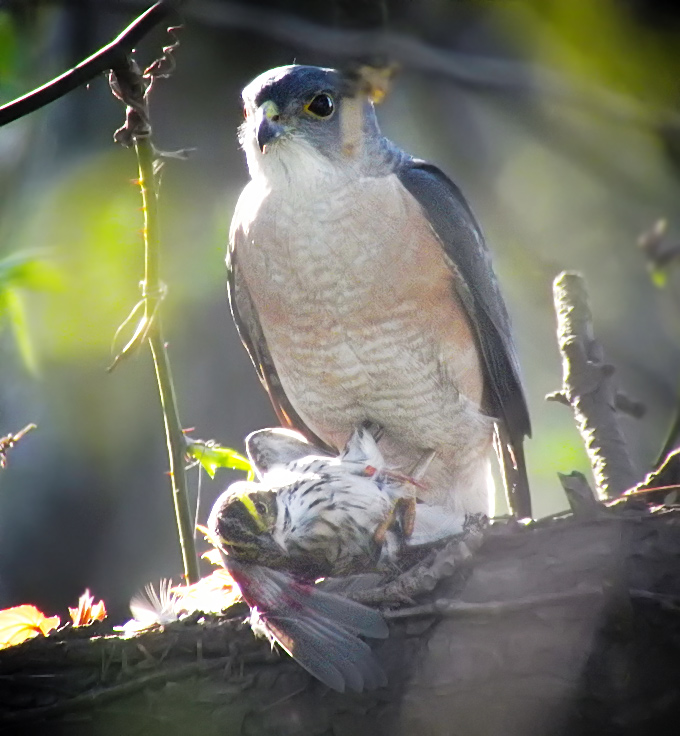
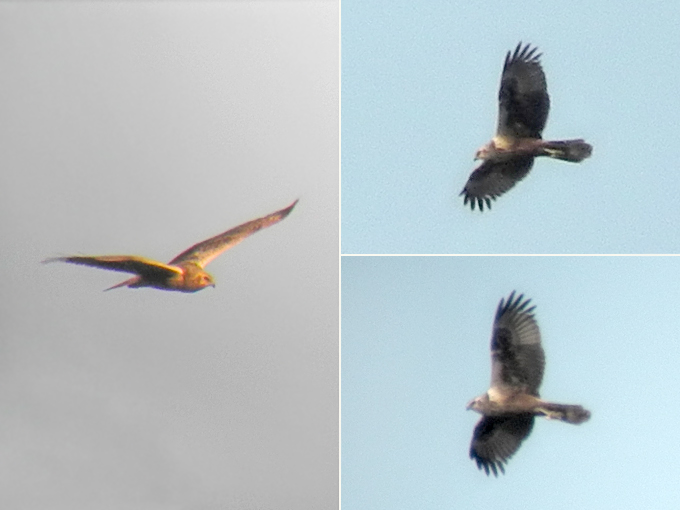


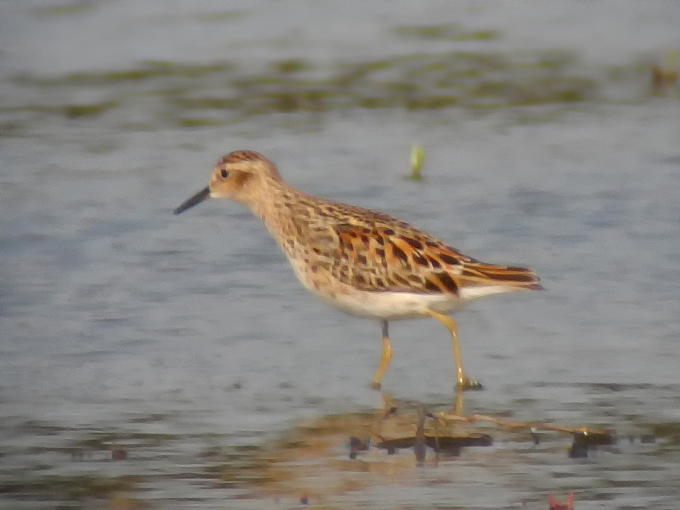
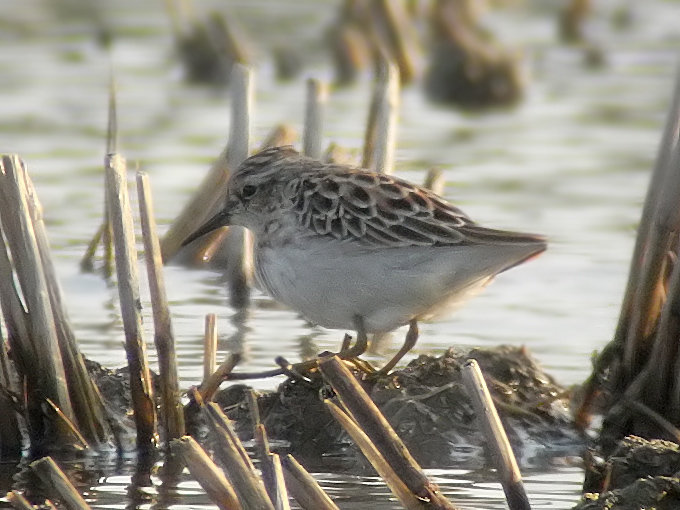

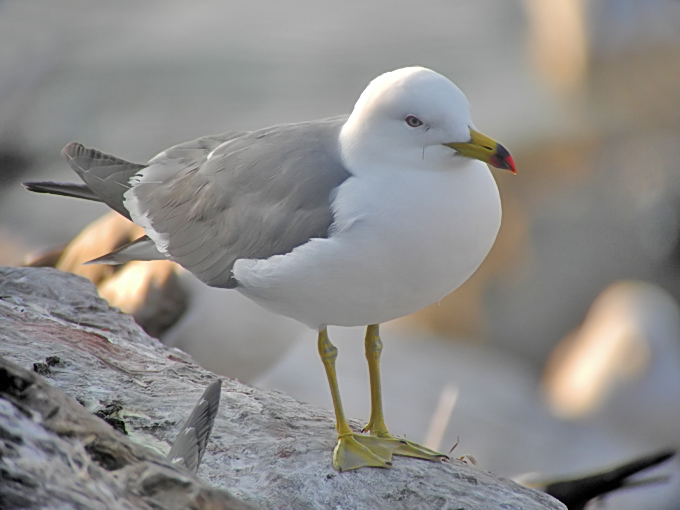





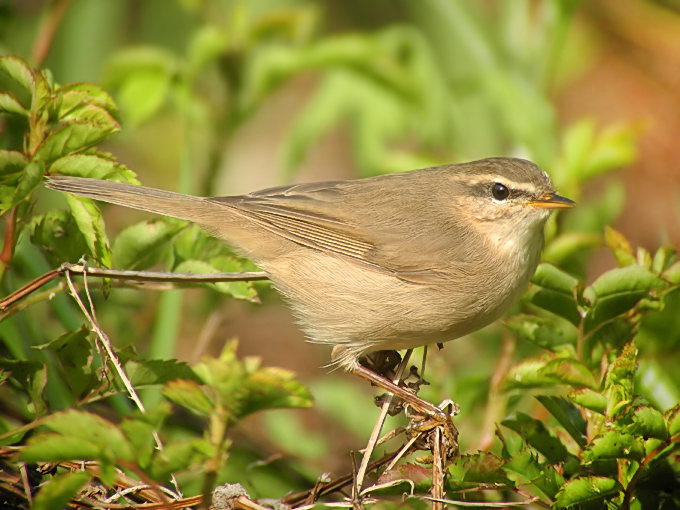
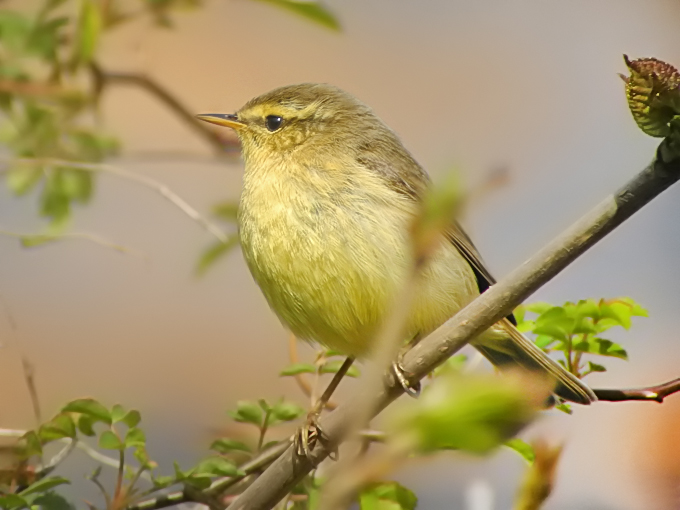
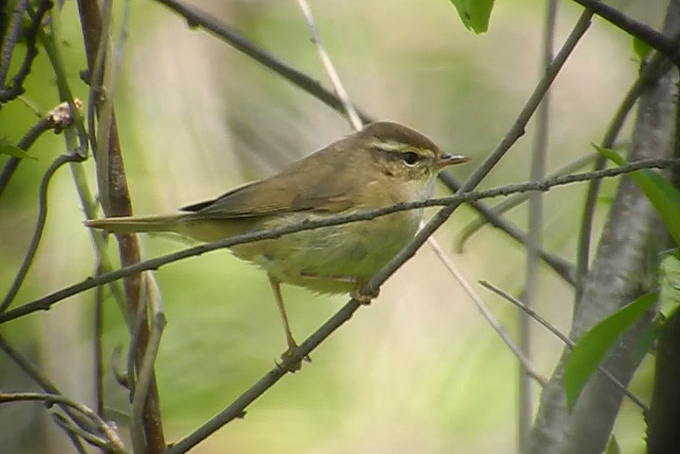

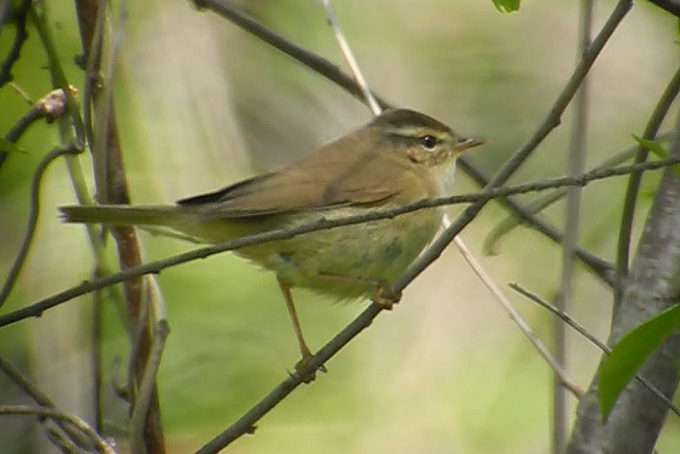

Soundsamples:
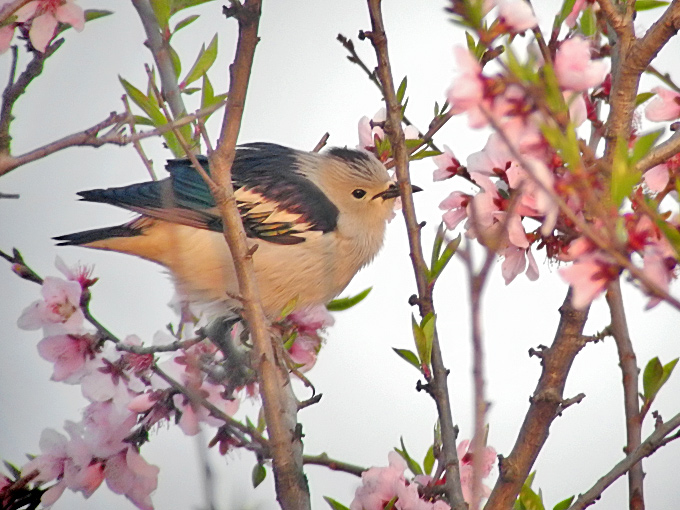




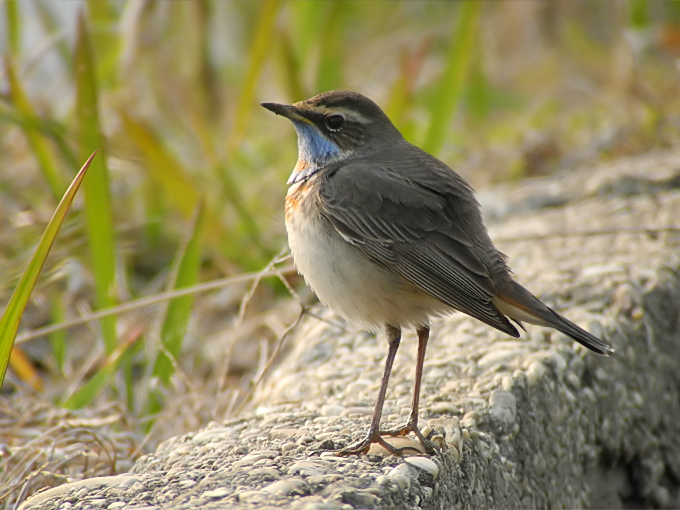
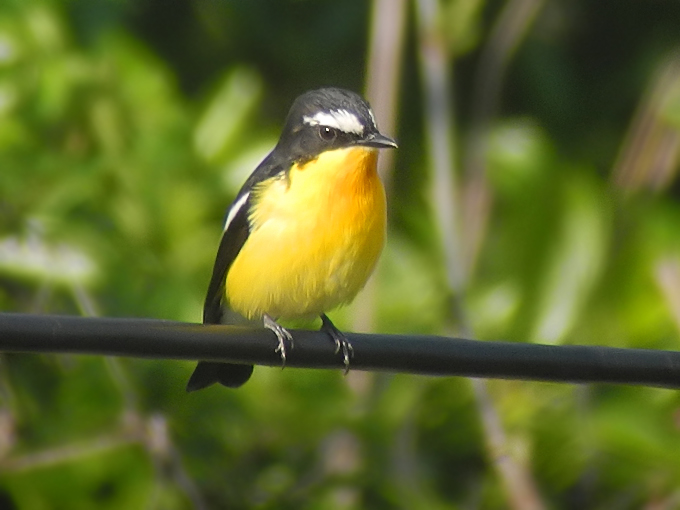


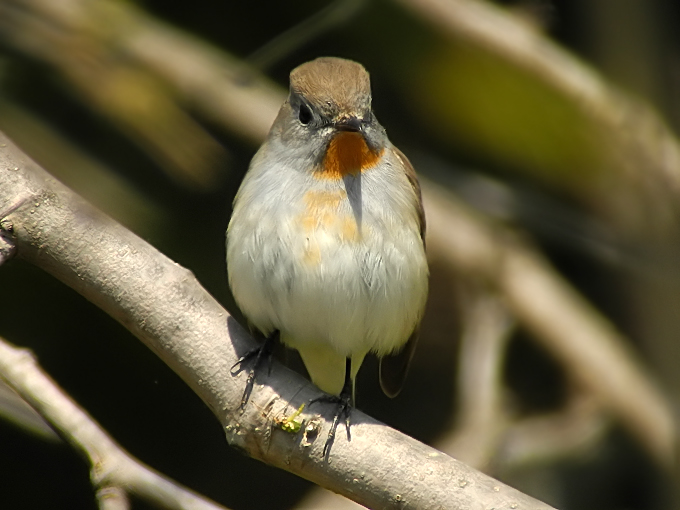

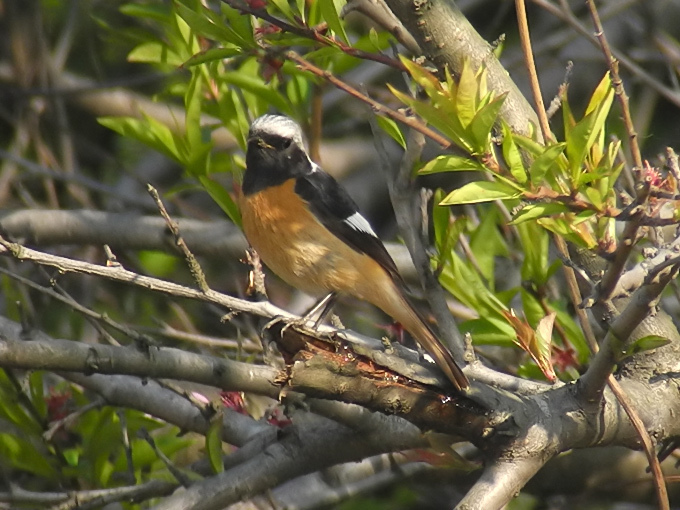

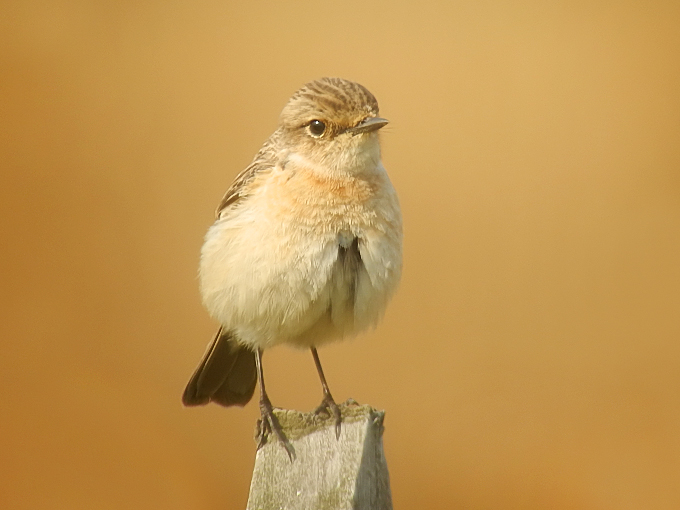


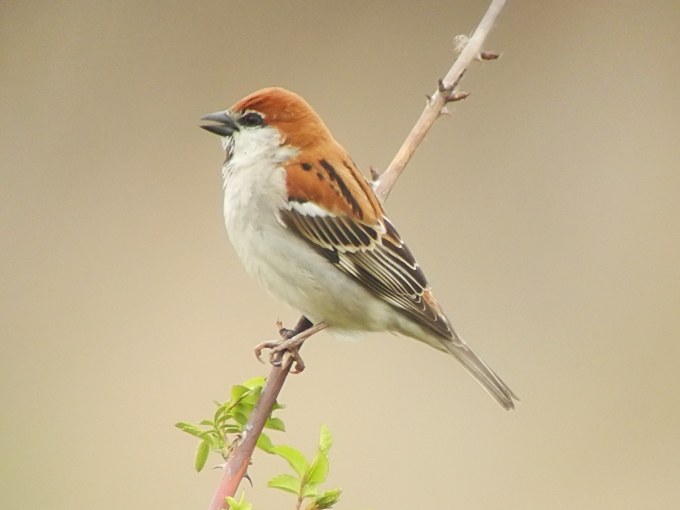


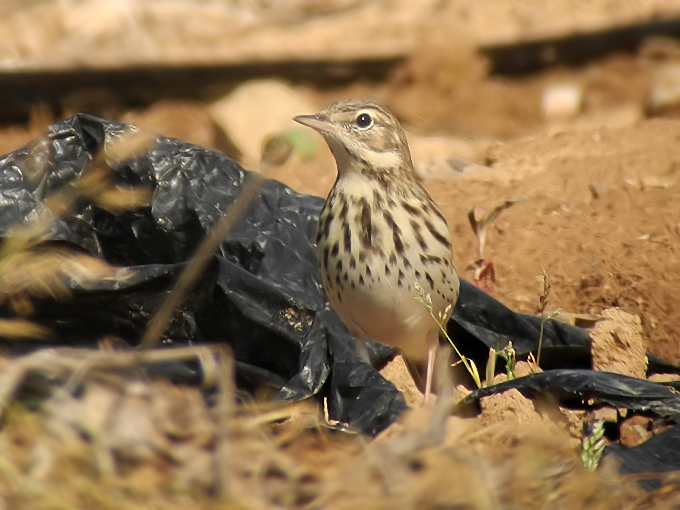


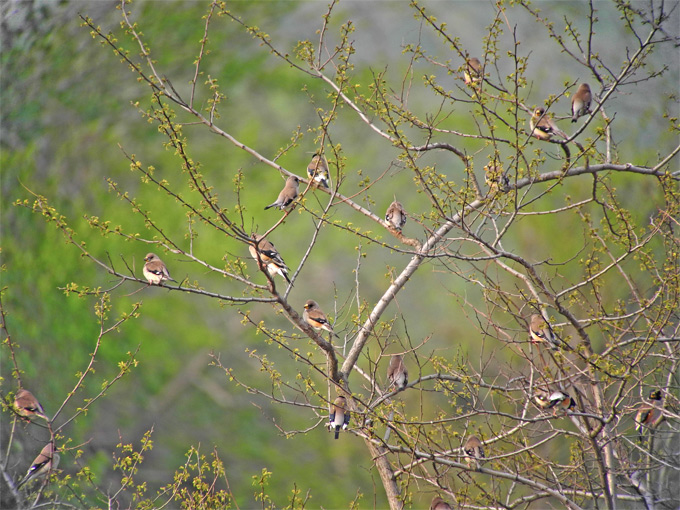


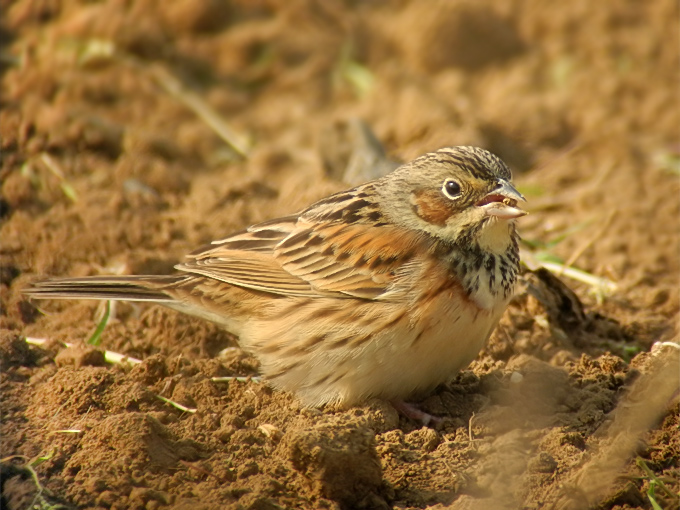
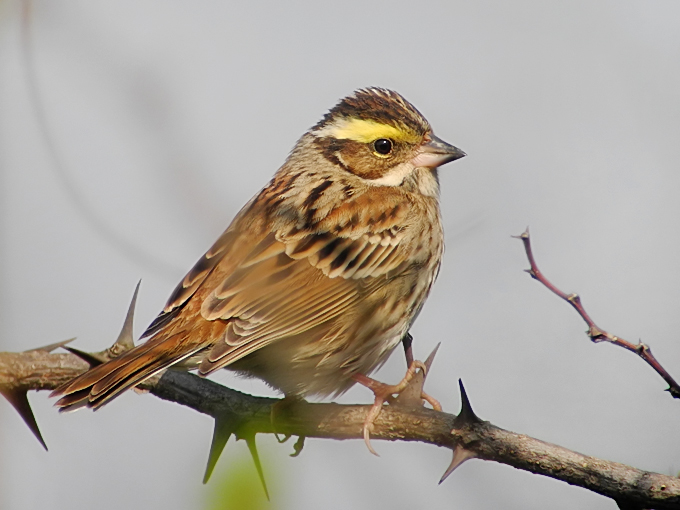

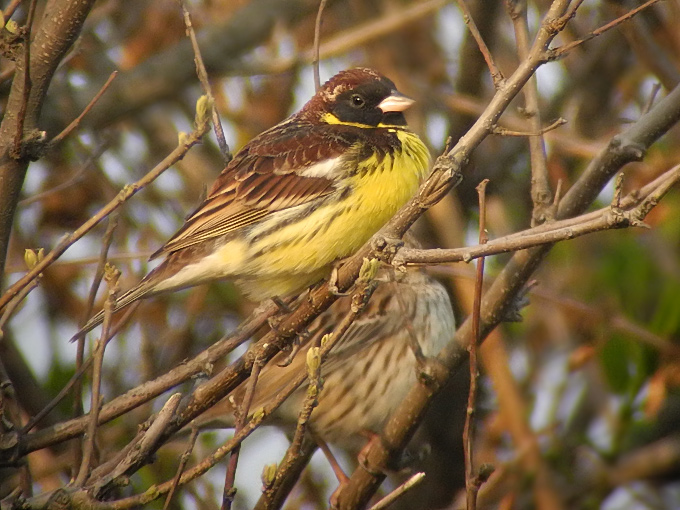
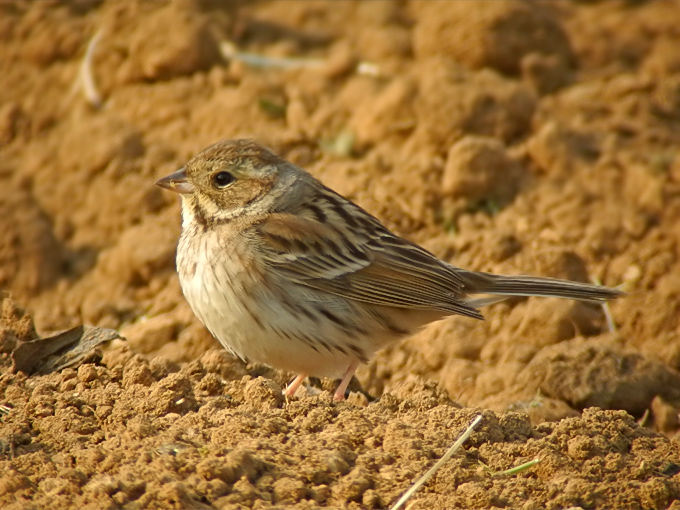



These survey results suggest that some species (like Yellow-browed Warbler and Chestnut-flanked White-eye) likely do cross on quite a broad-front, with birds probably arriving from the southwest and west in both westerly and northwesterly winds. Such winds therefore resulted in large fair-weather arrivals of multiple species on April 30th, May 1st and May 6th. In contrast, a few species (e.g. Crested Honey Buzzard) appear to have a much more focused route that likely takes many individuals through Socheong and onto Hwanghaenam, missing out Baekryeong altogether. Southwest and southerly winds (which often result in large numbers of birds arriving on Socheong, including southern overshooting species) failed to result in large arrivals on Baekryeong in either May 2013 or 2014; and some smaller species that are found commonly on Socheong (like Asian Stubtail) appear to be far less numerous on Baekryeong (perhaps because they arrive from the southwest and can disappear into deep cover on Socheong and Daecheong with few continuing on to Baekryeong).
While large numbers of some species were found during the survey and happily much excellent habitat still remains, habitat loss on Baekryeong (as elsewhere) continues apace – with a new road presently being constructed through the wetland at Hwadong (see: http://www.birdskorea.org/Habitats/Other/Baekryeongdo/BK-HA-Baekryeongdo-Hwadong-Marsh.shtml). In addition, a large part of the reedbed at Yeonhwa has been lost in the past year to yet another unattractive eco-park and to new roads; and many fields have also been lost since last year to new buildings or to ginseng orchards. What of the future if the present construction model fails to change?
This trip (my sixth to the island) was also the first to find evidence of small-scale bird-hunting on Baekryeong, with a boy spotted carrying an air rifle (and showing great interest in a flock of buntings) and three spring-traps found (each with a dead bird in it). On both occasions, the local police were called and responded immediately: many thanks to them for their speedy and efficient response.



